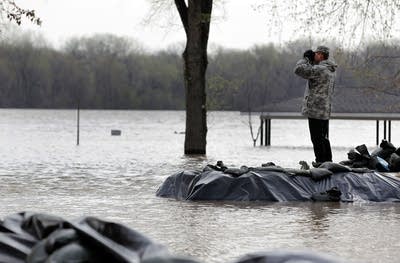Crests approaching in several towns in Midwest
Go Deeper.
Create an account or log in to save stories.
Like this?
Thanks for liking this story! We have added it to a list of your favorite stories.

By JIM SUHR and JIM SALTER, Associated Press
CLARKSVILLE, Mo. (AP) -- An all-too-familiar springtime ritual played out around the nation's heartland this weekend as volunteers, National Guardsmen and even prison inmates joined together in an effort to ward off fast-rising floodwaters.
Dangerously high waters dotted at least six Midwestern states after torrential rains this past week that dumped up to 7 inches in some locations. Record flooding was possible in some places as dozens of rivers overflowed their banks.
The water levels forced evacuations, closed roads, swamped hundreds of thousands of acres of farmland and shut down much of the upper Mississippi River to barge traffic.
Turn Up Your Support
MPR News helps you turn down the noise and build shared understanding. Turn up your support for this public resource and keep trusted journalism accessible to all.
Two Mississippi River bridges were closed and a third was shut down for a few hours after 114 barges broke loose Saturday night south of St. Louis and floated down the fast-moving river toward Jefferson Barracks Bridge in St. Louis County. The Missouri Department of Transportation shut down the bridge at 2 a.m. Sunday for an inspection; it reopened at 8 a.m.
"This isn't as bad as 2008, but thank God it stopped raining."
Because of the danger posed by the runaway barges, the U.S. Coast Guard shut down a 15-mile stretch of the river, much of which was already effectively closed between the Quad Cities and north of St. Louis after the Army Corps of Engineers shut down most locks in that stretch or river.
Coast Guard Petty Officer Michael Weelmaa said the barges had been moored along the side of the river when they broke free, and it wasn't clear how that happened. By midmorning Sunday, all of the barges had been corralled with help from several St. Louis-area tow operators, Weelmaa said.
Several Mississippi River towns north of St. Louis were expected to see crests sometime Sunday, including Clarksville, Mo.
Volunteers in the tiny community have worked endlessly since Wednesday to build a makeshift sandbag levee that seemed to be holding as the crest -- expected to be 11 feet above flood stage -- approached. Even prisoners from far-away Jefferson City were brought in to help.
Richard Cottrell, 64, emerged from his two-story brick home -- dating to 1845, the oldest dwelling in town -- around breakfast Sunday to walk his beagle and survey Mississippi's persistent rise. A sandbag wall just in front of his house was holding the river at bay as workers a half a block away hustled to fortify it.
After two days of endless sandbagging, Cottrell thought he could rest Saturday night, but the constant beeping of heavy equipment outside and flood worries kept him up.
"I had a rough night last night. I had an anxiety attack," said Cottrell, who also owns a downtown antique store.
Trish Connelly, 57, was optimistic the town would beat back the river. Her plan to open a new fine arts gallery downtown this weekend were on hold "until we know what the river is going to do," she said.
"This is frustrating for people," Connelly said. "This isn't as bad as 2008, but thank God it stopped raining."
Gov. Jay Nixon on Saturday toured the unprotected-by-choice town that was also flooded in 2008, 2001, 1998, 1995 and many times before that.
"The water is continuing to rise but it is our full hope and expectation that these walls will hold," Nixon said of the sandbag levees. Clarksville has a flood protection system in which a temporary levee -- aluminum slats filled with sand -- can be built if the river rises, but the Mississippi was too quick this time.
Recreational traffic on the river has been halted, too, including the Mark Twain Riverboat that offers excursions at scenic Hannibal, Mo. Owner and pilot Steve Terry has moored the ship since Thursday, with no end in sight.
Even crossing the river was difficult. One of two bridges at Quincy, Ill., closed Friday, and the narrow two-lane bridge at the Missouri town of Louisiana was shut down Saturday. To get across, people in the Louisiana, Mo., area either had to drive 35 miles north or 50-plus miles south.
Louisiana, Mo., resident Erica Campbell, whose rented home in a low-lying area of town was flooded for the second time in three years, and she said she's had enough. Campbell, her husband and their eight kids are packing up.
"We're planning to move to the country -- as far away from water as I can get," Campbell, 35, said.
Smaller rivers across the Midwest were swelling, too. In Illinois, heavy equipment manufacturer Caterpillar will shut down its East Peoria, Ill., factory Sunday as the Illinois River approaches an expected 30-foot crest early next week.
Several Indiana towns were threatened by high water, forcing hundreds of evacuations. The Wabash River in Tippecanoe County reached more than 14 feet above flood stage on Saturday, the highest level since 1958. Indiana Gov. Mitch Pence took a helicopter tour Saturday of damage in Kokomo, Tipton and Elwood.
The mayor of Grand Rapids, Mich., declared a state of emergency Saturday, the same day high water forced the evacuation of the Courtyard Marriott Hotel and an apartment building.
---
Salter reported from St. Louis. AP Photographer Jeff Roberson in Clarksville and Louisiana contributed to this report.




